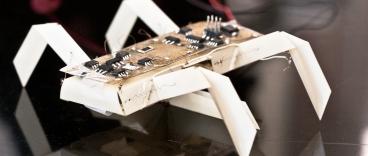May 16, 2013

Researchers from MIT and Harvard University have teamed up to design a 3D printed robot that can crawl like an inchworm and can assemble itself when given a jolt of electricity.
The research is part of a project funded by the National Science Foundation to develop desktop technology that would allow an average person to design, customize, and print a specialized robot in hours, according to MIT. Researchers from the University of Pennsylvania also are working on the five-year, $10 million project, "An Expedition in Computing for Compiling Printable Programmable Machines."
Daniela Rus, an MIT professor and project leader, told us in an email that the robots being designed for this project could have applications in numerous fields, because they can be assembled relatively quickly and inexpensively.

Rus and a team from MIT's Computer Science and Artificial Intelligence Laboratory collaborated with Professor Robert Wood and researchers from the Harvard Microbiotics Laboratory on the robotic inchworm, which was demonstrated last week at the IEEE International Conference on Robotics and Automation in Germany. "Applications of this technology range from education, manufacturing, healthcare, and entertainment," Rus said. "Rapidly fabricating and deploying new devices brings the design of robots to a new level of customization as a step towards democratizing access to robots."
For instance, the inchworm could be used to explore areas where humans can't go because they can't flatten themselves. Also, someone with a task at home that would benefit from robotic assistance could go to the local printing store, choose a blueprint from a catalogue of designs, and then customize and print a robot to solve the problem within 24 hours.
MIT said in a press release that scientists involved in the project are working on several areas of research: "developing an application programming interface for simple function specification and design; writing algorithms that would allow for control of the assembly of a device and its operations; creating an easy-to-use programming language environment; and designing new, programmable materials that would allow for automatic fabrication of robots."
So far, researchers have created two prototypes for the project that can be 3D printed -- the inchworm self-assembly robot and "a gripper that could be used by people with limited mobility."
Related posts:
About the Author(s)
You May Also Like



